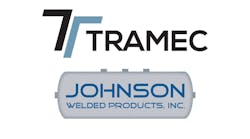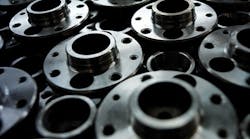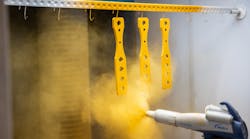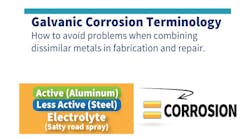The number is staggering: $276 billion. According to NACE International, that was the estimated direct cost of galvanic corrosion in the US. And that was in 2002.
“That’s about 3% of the GDP of the whole nation,” said Dan Szczepanik, technical manager for Sherwin-Williams.
No wonder he titled his presentation, “Galvanic Corrosion: A Low-Energy Current That Can Cause High-Dollar Problems.”
There are a lot of fancy and complicated chemical-composition formulas, but the simplified version involves three things that are needed for galvanic corrosion, which works like a battery:
- Dissimilar metals, or “fuel.”
- Dissimilar metals touching or in some way electrically contacted, or “transmission.”
- Electrolyte, a liquid that has ions in it, or “accelerator.”
An aluminum sheet plus a stainless bolt plus water equals galvanic corrosion.
“We see this a lot,” Szczepanik said. “Aluminum has great corrosion protection. Stainless steel has awesome protection. But when they are in contact and there’s water, it means corrosion.”
He said magnesium, zinc, aluminum and their alloys are the most susceptible to corrosive attack (or “less noble”). On the opposite side, platinum, gold, and silver are the least susceptible.
He said an electrolyte is anything—but typically liquid—that conducts electricity using free ions.
“A single metal with sodium chloride road salt is a problem,” he said. “Dissimilar metals with sodium chloride road salt is a bigger problem. Dissimilar metals with magnesium chloride or calcium chloride liquid is a huge problem.
“You’ve seen dry salt on your car trim all the time. Whenever rock salt gets wet and gets on your car, it dries fairly quickly into a nice white powder. When it’s dry, it has no corrosion. You’ve taken away the electrolyte. So it’s window of corrosivity is smaller. It will dry and then everything stops. The problem with mag chloride and calcium chloride is that they are put on wet and typically mixed with some kind of binding agent that will stick to the road and cause them to stay wet longer. Even though they are less conductive and less corrosive than sodium chloride, because it’s wet and mixed with a solution that’s getting up under trailers, it causes a huge problem. And it’s more water-loving in the first place.
“Size matters. A large cathode area (more noble) to anode (less noble) area ratio can lead to much higher corrosion rates for the anodic material. A large area of cathode touching a small area on anode is the worst-case scenario. The ideal thing would be to reverse that and have a large area of anode touching a small area of cathode. That could reduce the amount of corrosion you see. It would be a small area of aluminum touching a large area of stainless steel.”
Real-life examples
Where can it be seen in the industry and in the real world?
- Boat trailers and alloy boats.
“You’ve got metal in the trailer and some boats, and you could have a corroding cell in between them. A lot of people are switching to Teflon slides to make it easier to slide in and out and insulate. It will not transmit electrons from the trailer metal to boat metal.”
- Ambulance.
“You have an aluminum body, stainless fasteners, and a wheel well. There’s no coating on the inside and that wheel well stays wet all the time. To exacerbate it, they put foam tape along the body to prevent rubbing. That foam tape is just a sponge, so not only do you have all the moisture from the wheel well, but you have the foam tape holding the moisture for a long time, and every rivet along this area has white aluminum oxide bubbling up. There’s no paint that will prevent that. It’s guaranteed to happen.”
- Statue of Liberty. The famous statue is a great example of galvanic corrosion at work.
“You have copper rivets, wrought-iron armature, a copper saddle, and copper skin,” Szczepanik said. The outside skin is all copper. The inside is steel framing designed by (Alexandre) Eiffel to give it rigidity and structure in the late 1880s. They understood galvanic corrosion for the most part.
“There are 150 sections where the skin meets. They tried to prevent galvanic corrosion. They used asbestos soaked in shellac to prevent any contact. It worked for awhile. But the Statue of Liberty is right in the middle of a marine environment. Over time, the shellac broke down and the asbestos turned into a sponge, so it was holding the moisture and salt. These armatures lost about two-thirds of their mass wherever they were touching copper, so it was a ghost of itself inside. 1300 of 1500 of the copper saddles had to be replaced.”
A comprehensive design is the best prevention against corrosion.
“Focus on metal composition—sheet and fasteners,” Szczepanik said. “It’s not always possible to use the exact same fasteners but get them as close as possible or use one-piece construction, or use adhesives in place of fasteners. I know there are some adhesive that are stronger than welds out there right now so that’s another option. Just try to keep all metals the same.
“When dissimilar metals must be used, keep them close on the galvanic series chart or use coated/plated fasteners. Once they get violated or cut through, you could have some of that contact happening again. Insulate to keep them electrically isolated. Use non-absorbent and non-conductive washers, gaskets, and sleeves. Coat just the cathode or non-active metal, so if there is any break in coating, you’re in the best spot for the slowest galvanic corrosion possible. Avoid large areas of cathodes connected to small areas of anodes.”
Other tips:
- On flat pieces, use non-absorbent tape instead of caulk in the joining area. “We’ve seen caulks have cuts or discontinuous areas, and water can penetrate that area and stay there for long time.”
- Prevent moisture. “It’s one of the three conditions needed for galvanic corrosion. A typical coating like powder coating, that’s good. Be careful that stays encapsulated, and I’m talking about thick-film encapsulation. For instance, for that ambulance, nothing inside of the wheel well was coated. Only the outside. So one of solutions for them could be to take a different primer and thick-coat the inside of the wheel well so you don’t have the issue.”
- Sacrificial anode. “A zinc block in electrical contact to the problem area is an inexpensive way to short-circuit things. There’s no reason we couldn’t use a small one on trailers or utility bodies. So zinc is one of the largest anodes on that list. All you need to do is bolt that on the inside somewhere that’s not coated so it’s in direct contact with metal, and that thing will get corroded and the rest of the trailer will not. But you’ve got to be careful because that thing will last two years and then you have to replace it.”
He noted that once galvanized and galvanneal are sheared, blasted, drilled, and heavily sanded, uncoated steel is exposed and there’s no zinc left to protect or insulate.
“Some people sand a lot of their galvanized or galvanneal, and may sand that zinc off that’s giving them protection,” he said. “Remember, it’s a coated metal.”
How can we predict the design fitness?
Are the metals far enough away on the galvanic series?
Are the washers/sleeves working?
Is the coating/plating on the fasteners breaking during installation?
He said that any coating company work with a customer and say, “Here are some ideas. Let’s mock something up and figure out what’s going on.” Testing ahead of time is better than the alternative of just waiting to see.
“Create small mock-ups of body metal with fasteners, hinges, etc,” he said. “Investigate different combinations of metal or platings, pretreatments and coatings—any variable you want to test.”
There are three viable methods to perform testing:
- Salt fog (ASTM B117).
“It’s 73 years old,” he said. “Nothing against age, but 73 years old doesn’t cut it anymore. There’s zero correlation to real-world corrosion. Sometimes people have even argued it’s a negative correlation. I’m not buying that. But when you put it into a foggy environment at elevated temperatures, it just sits there. You get this weird environment. Sometimes you don’t see any correlation at all.”
- Cyclical corrosion (ASTM D5894 or SAE J2334).
“Your trailer isn’t sitting in a hot, salty environment 24/7. It gets warm and cold, gets wet and dry, sees salt and doesn’t. So this test tries to mimic real-world exposure. It goes through the cycle of salt fog and then dry heat, salt fog and then dry heat. This whole mix of elements is very similar to what a trailer would see in the real world. A 60% correlation is a huge number. We’re trying to push people to do a cyclical test. It takes a little bit longer than salt fog but we get better results.”
- Atmosphere exposure.
“The best correlation is actually putting it in a corrosive atmosphere, but this is going to take one to two years to test.”









